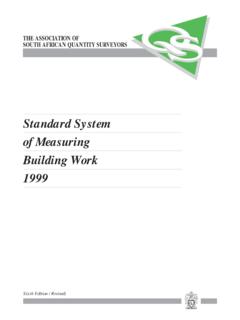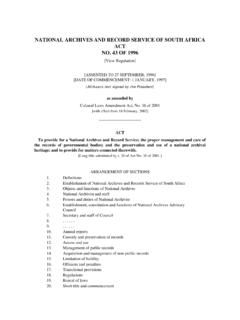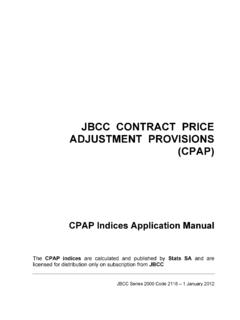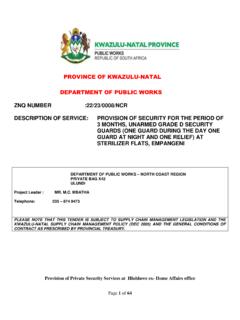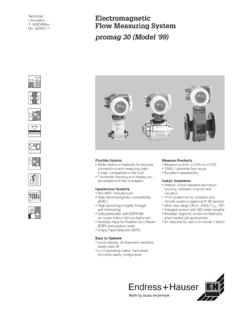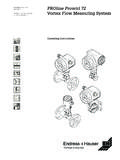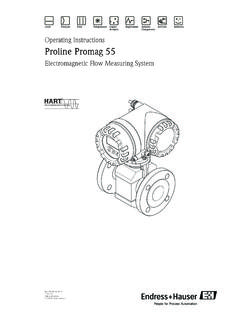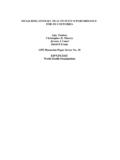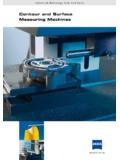Transcription of Standard System of Measuring Building Work 1999
1 Standard Systemof MeasuringBuilding Work1999 THE ASSOCIATION OFSOUTH AFRICAN QUANTITY SURVEYORSS ixth Edition (Revised) Standard SYSTEMOF MEASURINGBUILDING WORK(SIXTH EDITION)As early as the end of the previous century quantity surveyors and contractors reached consensus on the neces-sity for a Standard method of measurement for the preparation of bills of quantities for Building workThe first Standard System for the measurement of Building work in South Africa was published in 1906 by theTransvaal Society of Quantity Surveyors. Thereafter Standard systems were published at irregular intervals on anational level and the fifth edition thereof, which has been in use up to the time of this edition, appeared in 1977A comparison between the 1906 and the fifth editions reveals an enormous development and much morefragmentation from a System prescribing only how to measure the principal materials and labour to a systemprescribing the measurement of almost all material and labour in the finest detailIt is precisely this progressive tendency of development that led to the Standard System becoming tootheoretical with consequent unnecessary items in bills of quantities.
2 Furthermore the question arises as towhether it is worthwhile to spend so much time on the preparation of unnecessary comprehensive bills of quan-tities in this era of high inflation and/or high interest rates whilst many of the theoretical items in bills of quanti-ties are not scientifically priceableWith this in mind the Standard System Joint Committee began in earnest in November 1981 with the task ofproducing a sixth edition whilst they were still engaged with necessary amendments to the fifth edition. It was achallenging task especially seen in the light of the attempt to fulfil the premise of simplification on the one handand the many organisations in the industry on the other hand that had to be satisfied. The result istherefore in certain instances a compromiseThis sixth edition is the product of dedicated work over a period of ten years by an extremely capablecommittee who remained aware of their responsible task at all times.
3 It was a great honour and privilege to beassociated with such a committeeH M Sigl Chairman: Standard System Joint CommitteeOctober 1991 Standard System OF MEASURINGBUILDING WORK (SIXTH EDITION)PREFACEAs stated in the Preface above, the committee responsible for the drafting of the sixth edition faced thechallenging dual task of attempting to simplify the Standard System on the one hand and to satisfy the demandsof the Building industry on the other hand. This compromise did not satisfy everybody and the new BIFSA rep-resentatives on the Standard System Joint Committee submitted a list of items to be reconsidered. As a resultof the foregoing and coupled with other evolutionary changes, amendments to the sixth edition were issued in1996 (twice), 1998 and reprint of the sixth edition became necessary because stocks reached exhaustion.
4 The Board of theAssociation of South African Quantity Surveyors decided at their November 1998 meeting to publish a revisededition incorporating all the abovementioned amendments. It was further decided to make this documentavailable in a more economical format with the option of purchasing either an English or an Afrikaans versionMJ MaritzChairman: Standard System Joint CommitteeFebruary 1999 The Board of the Association of South African Quantity Surveyors decided in 1981 to commence with thecompilation of the sixth edition of the Standard System of Measuring Building Work and accordingly commis-sioned the Standard System Joint Committee to carry out this extensive taskAfter a fruitless attempt to reach consensus with the Building Industries Federation South Africa (BIFSA) on theuse of a unilaterally produced simplified Standard System which was to be used in conjunction with the fifth edi-tion, one of the main directives for this commission was that the compilation of the sixth edition had to focus onsimplification this time, however, with the co-operation of BIFSA through representation on the committeeThe result of the committee s work, the sixth edition, heralds a new era in the measurement of only has the instruction to simplify been adhered to but uniformity of principles has also been achieved to agreat extent.
5 Use has also been made of the so-called deeming clauses which should result in brevity ofdescriptions in bills of quantities. Meaningful merging as well as certain necessary additions were alsoincorporatedThe fact that this edition is the sixth, illustrates that the quantity surveying profession is a live one, prepared toadapt to changes. It will by no means be the last edition. There must be constant monitoring of the demands ofeach era and adaptations made accordinglyThe entire Building industry is greatly indebted to the committee for an unselfish service delivered withoutremuneration over a period of ten years. The committee responsible for the translation of the document intoAfrikaans also deserves our gratitude for its valuable contributionThe Standard System Joint Committee consisted Sigl PhD (QS) (chairman)A.
6 Scatterty BSc (QS) (secretary and editor) Br mmer BSc (QS) (from March 1986)R. de Villiers BSc (QS) Haylett DIP (QS) (until February 1986) Hurry BSc (QS) (representative of BIFSA from March 1983) Klopper BA, DSc (QS) Maritz MSc (QS)F. Mayston BSc (QS) (representative of BIFSA) Pearmain DIP (QS) (until February 1986) Reid DIP (QS) (from March 1986) Urry DIP (QS) Walker BSc (QS) (from March 1986) Zylstra BSc (QS) (representative of BIFSA until June 1985)The translation committee consisted Klopper DIP (QS) (chairman) Cronje BSc (QS)A. Frylinck DIP (QS) Klopper BA, DSc (QS) Roos BSc (QS)K. van der Laan DIP (QS) SCHOOMBIEP residentAssociation of South African Quantity SurveyorsOctober 1991 Standard System OF MEASURINGBUILDING WORK (SIXTH EDITION)GENERAL1 Method and procedure62 Bulking6 DEMOLITIONS AND SITE CLEARANCE3 Demolitions etc64 Site clearance6 EXCAVATIONS, FILLING, ETC5 Nature of material to be excavated66 Excavations67 Classification of material to be excavated78 Removal of services79 Carting away of excavated material710 Risk of collapse of excavations711 Working space712 Keeping excavations free of water713 Dewatering7(i)
7 CONTENTSPageGENERAL INSTRUCTIONS1 Bills of quantities12 Setting out of bills of quantities13 Order of items14 Order of dimensions15 Net measurements16 Fractional quantities27 Provisional quantities28 Provisional sums29 Contingencies etc2 PRELIMINARIESP reliminaries3 ALTERATIONS1 General42 Old materials43 Barricades, screens, etc44 Removals45 Alteration work46 Openings47 Building up openings58Re-use of existing components59 Work in patches510 Sundries5 EARTHWORKS(ii)LATERAL SUPPORTGENERAL1 Removal of lateral support92 Insurance93 Movement monitoring9 GROUND ANCHORING4 Descriptions95 Establishment96 Test anchors97 Ground anchors98 Waterproofing of ground anchors99 Testing, re-tensioning and de-stressing of ground anchors910 Rock bolts and rock dowels1011 Soldiers, boarding, shotcreting, etc10 PLANKING, STRUTTING AND SHORING12 Planking and strutting1013 Shoring units10 LATERAL SUPPORT PILING14 Lateral support piling1014 Filling815 Foundation courses816 Compaction of surfaces817 Grassing, pitching, Gabions and interlocking block retaining structures819 Filter fabric820 Weedkillers, insecticides.
8 Etc821 Tests8 PILINGGENERAL1 Site conditions112 Nature of the work113 Establishment114 Setting up115 Excavations116 Reinforcement117 Exposing piles for inspection118 Cutting off etc119 Testing11 PREFABRICATED PILING10 Precast concrete piles1111 Steel piles1212 Sheet piling12(iii)CONCRETE CAST IN SITU PILING13 Augered piles1214 Driven, bored or similar tube piles1215 Disposal of excavated material12 CONCRETE, FORMWORK AND REINFORCEMENTCONCRETE1 Classification132 Scope and unit of measurement133 Composite slabs etc134 Shotcrete135 Projections136 Shaped tops and striking off and curing137 Surface treatment138 Grooves, channels, mortices, etc139 Bedding under base plates etc1310 Test blocks14 FORMWORK11 General1412 Scope and unit of measurement1413 Propping etc1414 Columns1415 Slabs1416 Edges, risers, etc1517 Projections, grooves, etc1518 Openings1519 Movement joints etc15 REINFORCEMENT20 General1521 Classification1522 Bar reinforcement1623 Special reinforcement1624 Fabric reinforcement1625 Pre-tensioned or post-tensioned reinforcement1626 Tests16 PRECAST CONCRETE1 Classification172 Formwork173 Reinforcement174 Bedding, jointing.
9 Etc175 Unit of measurement176 Wall linings177 Copings, sills, etc178 Slab paving179 Joint sealants, jointing strips, etc17(iv)10 Holes, notches, etc1711 Cramps, dowels, brackets, etc17 MASONRYGENERAL1 Classification182 Descriptions183 Circular work184 Concrete filling18 BRICKWORK5 Mass brickwork and piers186 Walls and linings187 Beamfilling188 Vaulting189 Lintels1910 Forming toothings and bonding1911 Hacking face or raking out joints for key1912 Battered and oversailing faces1913 Building brickwork to a fair face1914 Bagging1915 Flues1916 Splayed mortar fillets in cavities1917 Closing cavities1918 Projections and cores1919 Rough arches1920 Rough niches1921 Joint forming material in movement joints2022 Reinforcement to brickwork2023 Fabricated lintels2024 Turning pieces2025 Face brickwork2026 Walls faced both sides2027 Cut face brick linings2028 Fair cutting to face brickwork2029 Special face bricks at angles2030 Face brick bands2031 Face brick copings, lintels, sills.
10 Etc2032 Face brick arches2133 Face brick niches21 BLOCKWORK34 General2135 Piers2136 Standard complementary blocks at corners, ends, etc2137 Special blocks for copings, sills, lintels, etc21 PAVING ETC38 Paving21(v)RUBBLE WALLING39 Mass and irregular rubble work2140 Walls and linings2241 Beamfilling2242 Facing and pointing2243 Copings, sills, etc2244 Pitched angles2245 Trimming to receive plaster etc2246 Flues2247 Niches2248 Turning pieces and centres22 STONEWORK49 Classification2250 Labours2251 Ashlar walling, linings and paving2352 Margins, skirtings, cornices, etc2353 Mouldings2354 Columns, piers, etc2355 Special features2356 Rough rebates, grooves, etc2357 Fair edges, angles, etc2358 Holes, notches, etc2359 Cramps, dowels, etc2360 Turning pieces and centres23 MISCELLANEOUS61 Quarry tiles, cement tiles, fibre-cement, etc2362 Ornamental blocks, glass blocks, etc2363 Hoop iron ties, cramps, etc2464 Air bricks etc2465 Fireplaces2466 Special features24 WATERPROOFINGDAMP PROOF COURSE1 General25 SHEET OR MEMBRANE WATERPROOFING2 General253 Preparatory work.
